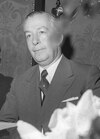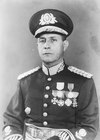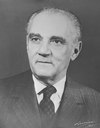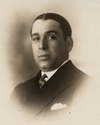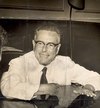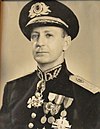Presidency of Eurico Gaspar Dutra
 | |
| Presidency of Eurico Gaspar Dutra January 31, 1946 – January 31, 1951 | |
Vice President | |
|---|---|
| Party | PSD |
| Election | 1945 presidential election |
| Seat | Catete Palace |
|
| |
The presidency of Eurico Gaspar Dutra began on January 31, 1946, after he won the 1945 election with 3,251,507 votes against 2,039,341 votes for Eduardo Gomes, making him Brazil's 16th president. It ended on January 31, 1951, when Getúlio Vargas took office.[1]
His administration was characterized by the outbreak of the Cold War, with Dutra fully aligning himself with the United States and tearing up relations with the Soviet Union. The period also witnessed discussions on oil policy, the ban on gambling in Brazil, which has lasted to this day, and the SALTE Plan. During his time in office, Brazil's GDP grew by an average of 7.6%, one of the highest growth rates in the country's history.[1][2]
1945 elections
[edit]Dutra stood as a candidate for the Social Democratic Party (PSD), in coalition with the Brazilian Labor Party (PTB), and won the elections on December 2, 1945, with 3,351,507 votes, beating Eduardo Gomes of the National Democratic Union and Yedo Fiúza of the Communist Party of Brazil. The 1945 elections took place under the 1937 constitution, which did not include a vice-president. However, Nereu Ramos, a politician from Santa Catarina, also from the PSD, was chosen for the post by the 1946 National Constituent Assembly.[1]
Presidency
[edit]Inauguration
[edit]
Dutra took office on January 31, 1946, along with the inauguration of the National Constituent Assembly, in a climate of freedom after years of Vargas' dictatorial regime. To establish a democratic rule that lasted 19 years, a constitutional pact was made between the major parties of the liberal center, the PSD and the UDN, although left-wing parties such as the Communist Party of Brazil (PCB) and the PTB were also active. Dutra did not interfere in decisions, even when his term was reduced from six to five years. His presidency, which began with the prohibition of gambling in Brazil, entered its most characteristic phase in 1948, marked by the decision of the Superior Electoral Court declaring the PCB to be outside the law and later by the rupture of relations with the Soviet Union.[1]
Ministries
[edit]Overall, the ministers were linked to Vargas, but from May 1946, when the UDN held a national convention, Dutra definitely oriented his policy towards a conservative alliance. The exception was João Neves, who left his post in July and was replaced on an interim basis by Samuel Gracie. Edmundo de Macedo Soares also left the ministry, only to be elected governor of the state in 1947. Neto Campelo contributed to the division of the PSD in Pernambuco with his anti-Vargas orientation, as did Carlos Luz in Minas Gerais.[3]
Economy
[edit]Dutra tried to use the principles of laissez faire liberalism, suspending exchange rate controls and allowing the import of manufactured goods to avoid a rise in inflation.[3][4]
Dutra's trade policy was criticized for its poor use of the foreign currency accumulated during the war, and for misjudging the situation of the reserves. In 1946, half of the savings were in gold and the other half, US$235 million were in blocked pounds sterling and only US$92 million were actually liquid and usable in countries with convertible currencies. One of the origins of the problem was that Brazil had a surplus with inconvertible currency areas and deficits with the US and other countries. Also, in the post-war period, there was no influx of public or private capital into Brazil, which was not a priority in the new global context.[5][6]
The overvalued exchange rate, by discouraging the supply of the product, could be used to support international coffee prices, but it acted as a disincentive to the export sector, deflecting investment towards production for the domestic market. The spurt of economic development that resulted from this policy was called "spontaneous industrialization", which was assisted by a more liberal credit policy. Between 1946 and 1952, the average annual growth rate of real output was 6.2%, while industrial output grew by 7.9%. The composition of GDP changed: agriculture went from 37% in 1939 to 31.8% in 1951, while industry grew from 17.5% to 19.6% in the same period. Supported by the inauguration of the Companhia Siderúrgica Nacional, Brazilian steel production rose from 205,935 tons in 1945 to 788,557 tons in 1950.[5][7]
During this period, the cost of living rose by 60%, but the minimum wage remained the same as Vargas had set it in December 1943 (between 240 old cruzeiros in Recife and 380 in Rio de Janeiro).[5]
Infrastructure
[edit]
Based on a developmentalist approach, Eurico Dutra gathered suggestions from various ministries and gave priority to four areas: Health (Saúde), Food (Alimentação), Transport (Transporte) and Energy (Energia), whose initials form the acronym SALTE. The resources for implementing the SALTE Plan would come from the Federal Revenue Service and foreign loans. However, the resistance of the conservative coalition and the orthodoxy of the economic team eventually made the plan unviable.[5][8]
During Dutra's administration, BR-2 (now Rodovia Presidente Dutra), the highway linking Rio de Janeiro to São Paulo, was built and inaugurated; in 1967, it was duplicated. On leaving office, Dutra's road policy was praised by the press. An editorial in the newspaper A Noite stated that it was the sector that had produced the most "voluminous and fruitful" results, with the alleged construction of 500 km of roads during his administration.[9]
Oil policy
[edit]In 1945, the president of the National Petroleum Council (CNP), Colonel João Carlos Barreto, defended the participation of foreign private capital in the oil industry, as long as it was integrated into companies incorporated in Brazil, contrary to the 1937 Constitution; this argument was used in the drafting of the 1946 Constitution.[10][11]
In February 1947, Dutra appointed a commission, under the direction of the CNP, to draw up the Petroleum Statute, to define how the country, whose consumption of the product was growing rapidly, would deal with the problem. During the drafting process, the Oil Campaign was created with the slogan "O petróleo é nosso" (English: "Oil is ours").[10]
The Statute was sent to Congress at the beginning of 1948, without Dutra's clear opinion, as if it were a study and not a bill. The document established the principle of the product's public utility clearly, but considered total nationalization impossible due to a lack of funds and specialized technicians. When it was published, it displeased everyone, both the nationalists, who adopted the thesis of a state monopoly, and the big corporations, who wanted to exploit Brazilian oil in the same way as Venezuelan oil.[12]
In April 1948, the Center for the Study and Defense of Oil and the National Economy (CEDPEN) was created, with Artur Bernardes and generals Horta Barbosa, José Pessoa and Estêvão Leitão de Carvalho as its honorary presidents. In October, the organization formally adopted, at a national convention, the thesis of a state monopoly for all phases of oil exploration.[13]
Main measures
[edit]
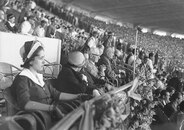
Dutra created the General Staff, which would later become the Brazilian Army General Staff (EMFA). During his administration, the federal territories of Ponta Porã and Iguaçu were abolished. On April 30, 1946, he banned gambling in Brazil and demanded the closure of all casinos.[14][15][16][17]
Sport and culture
[edit]On September 18, 1950, TV Tupi, the first television station in Brazil and South America, was inaugurated. Between June 24 and July 16 of that year, Brazil hosted the FIFA World Cup, the first after World War II. In the final match, the Uruguayan team defeated Brazil at the Maracanã Stadium and lifted the World Cup title.[18][19]
Foreign relations
[edit]The Dutra government's foreign policy was strongly marked by the outbreak of the Cold War and anti-communism, including the rupture of diplomatic relations with the Soviet Union.[20] Between August 15 and September 2, 1947, the Inter-American Conference for the Maintenance of Peace and Security of the Continent was held, which was attended by US President Harry Truman and approved the Inter-American Treaty of Reciprocal Assistance (TIAR), commonly known as the Treaty of Rio de Janeiro. It established that "an armed attack by any country against an American state shall be considered an attack against all American states."[21][22]
In May 1949, Dutra made a 10-day visit to the United States, becoming the first Brazilian president to do so, but the results were rather modest.[23]
See also
[edit]References
[edit]- ^ a b c d "Governo Dutra". Uol. Retrieved 2023-11-02.
- ^ "PIB DOS PRESIDENTES DO BRASIL". Globo. Retrieved 2023-02-10.
- ^ a b "DUTRA, Eurico Gaspar". FGV. Retrieved 2023-02-10.
- ^ Van der Lann, Cesar; Cunha, André; Fonseca, Pedro (2012). "Os pilares institucionais da política cambial e a industrialização nos anos 1930". Brazil. J. Politica Economica. 32 (4).
- ^ a b c d Amorim, Karla de (1999). "Da intenção à ação: o Ministério da Fazenda no Governo Dutra (1946–1950)" (PDF). USP.
- ^ Reigoto, Luhan; Mattos, Fernando; Cerqueira, Luiz. "Aspectos cambiais do Governo Dutra (1946–1951)" (PDF). Anpec 3.
- ^ Andrade, Maria Lúcia; Cunha, Luiz Mauricio. "O SETOR SIDERÚRGICO" (PDF). BNDES 50 anos.
- ^ "PLANO SALTE". FGV. Retrieved 2023-02-10.
- ^ Bazani, Adamo (2016-01-17). "História da Rodovia Presidente Dutra: 65 anos e um caminho aberto para o desenvolvimento". Diário do Transporte. Retrieved 2017-07-29.
- ^ a b Cotta, Pery (1975). O petróleo é nosso?. Rio de Janeiro: O petróleo é nosso?.
- ^ "BARRETO, João Carlos". FGV. Retrieved 2023-02-11.
- ^ Cohn, Gabriel (2017). Nacionalismo e Petróleo. São Paulo: Difusão Européia do Livro.
- ^ "Campanha "O petróleo é nosso"". RioMemorias. Retrieved 2023-11-02.
- ^ Westin, Ricardo (2016-02-12). "Por 'moral e bons costumes', há 70 anos Dutra decretava fim dos cassinos no Brasil". Senate. Retrieved 2023-02-11.
- ^ "ESTADO MAIOR DAS FORCAS ARMADAS (EMFA)". FGV. Retrieved 2023-02-11.
- ^ "Território Federal de Ponta Porã". UOL. Retrieved 2023-11-02.
- ^ "Território Iguaçu no sul do Brasil". Uol. Retrieved 2023-11-02.
- ^ Izel, Adriana (2020-09-18). "Há 70 anos, a televisão foi inaugurada no Brasil; relembre a história". Correio Braziliense. Retrieved 2023-11-02.
- ^ Araújo, Felipe. "Copa do Mundo de 1950". InfoEscola. Retrieved 2023-11-02.
- ^ Rezende, Renato Arruda de (2007). "1947, o ano em que o Brasil foi mais realista que o rei: o fechamento do PCB e o rompimento das relações Brasil-União Soviética". UFGD.
- ^ "DECRETO Nº 25.660, DE 13 DE OUTUBRO DE 1948". Federal Government of Brazil. Retrieved 2023-11-02.
- ^ "B-29: INTER-AMERICAN TREATY OF RECIPROCAL ASSISTANCE (RIO TREATY)". OAS. Retrieved 2023-02-10.
- ^ Savarese, Mauricio (2011-03-18). "Acordos modestos e gafes marcam visitas de presidentes dos EUA ao Brasil". Uol. Retrieved 2023-02-11.




